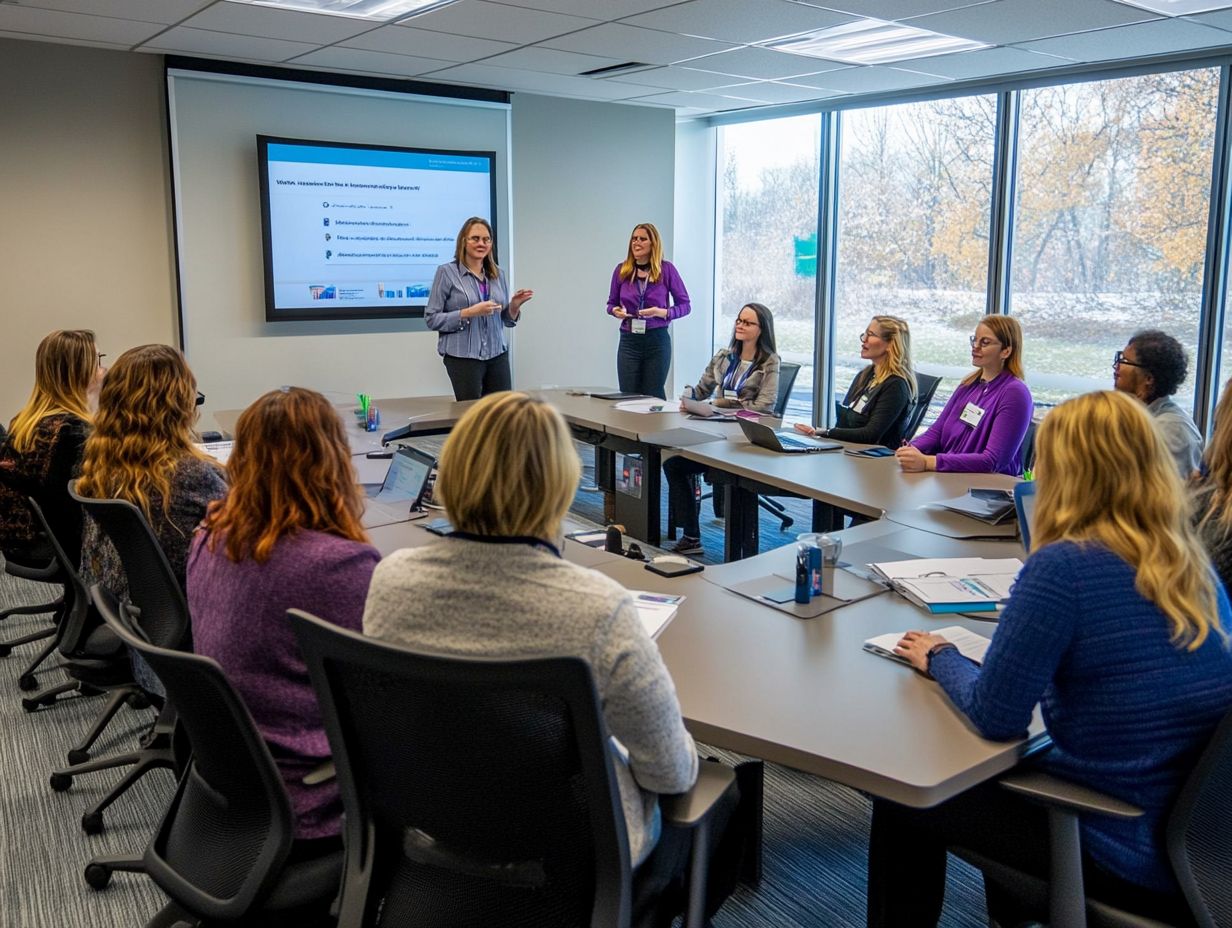The Role of Communication in Employee Onboarding
Effective employee onboarding is essential for establishing a foundation for success within your organization.
Discover the incredible advantages of a well-structured onboarding process! This article explores the benefits for both employees and employers. It highlights the critical role communication plays in this journey, exploring effective strategies, key components of a communication plan, and the most effective channels to employ.
You’ll also discover methods to measure the success of your communication efforts during onboarding.
Explore vital steps to craft a seamless onboarding experience that sets everyone up for triumph.
Contents
Key Takeaways:

- Effective communication plays a critical role in successful employee onboarding. It helps new hires feel welcomed, informed, and engaged from day one.
- A well-crafted communication plan should include clear objectives and tailored messaging. Use a variety of channels to ensure effective onboarding for all employees.
- Measuring the effectiveness of communication during onboarding provides valuable insights. This can improve future processes and contribute to the success of the organization.
The Importance of Employee Onboarding
Employee onboarding is a fundamental process that shapes the future of new hires within an organization. An effective onboarding program does more than just bring employees up to speed; it accelerates their engagement and creates a positive company culture, which is essential for long-term retention.
Set clear expectations from the start. This helps new hires feel supported and seamlessly integrated into their teams. As a result, overall productivity and satisfaction increase.
Research shows that a well-structured onboarding experience can significantly lower new employee attrition (loss of employees) and strengthen organizational alignment. This ultimately drives improved performance across the board.
Understanding the Benefits for Organizations
Understanding the benefits of employee onboarding helps create a productive work environment and reduce new hire turnover.
An effective onboarding process accelerates the integration of new hires into your company culture. It also significantly enhances their initial performance and engagement levels.
According to the Society for Human Resources Management (SHRM), organizations with strong onboarding processes can achieve up to 82% higher retention rates within the first year. This mitigates the costs associated with turnover and creates a more inclusive and collaborative workplace atmosphere.
When you implement comprehensive onboarding programs, you ll likely see a remarkable boost in employee productivity. New hires who feel welcomed and supported are more inclined to exceed performance expectations.
The Role of Communication in Onboarding
Effective communication is crucial in the employee onboarding process, as it sets clear expectations and cultivates a sense of belonging for new hires. Understanding the role of feedback in employee onboarding can further enhance this experience.
By prioritizing onboarding communication, you enhance integration and deepen understanding of company policies, culture, and values.
Your human resources team plays a vital role in delivering consistent messages across various channels. This ensures that new employees receive the mentorship and guidance they need throughout their onboarding journey.
Maintaining open lines of communication encourages feedback and evaluation, essential for continuously improving the onboarding experience.
Effective Communication Strategies

Implementing effective communication strategies is crucial for a successful onboarding experience. Additionally, understanding the role of technology in employee onboarding enables you to align your internal communication efforts with the needs of new hires.
By cultivating an environment where new employees feel enabled to voice their thoughts and concerns, you can foster a more inclusive workplace culture. Tailoring your communication to meet individual preferences whether through one-on-one meetings, group discussions, or even digital platforms can significantly enhance understanding and engagement.
Industry leaders emphasize the power of active listening. This ensures that new hires feel heard and that their feedback can influence necessary adjustments in the training process.
Regular check-ins and feedback loops create a framework for continuous improvement. This makes sure that every onboarding experience is supportive and relevant to the specific challenges faced by your new team members.
Creating a Communication Plan for Onboarding
Crafting a communication plan for onboarding demands an organized plan that distinctly defines expectations and delineates the essential components of the onboarding experience. This plan should cover various critical elements, including the onboarding timeline, details of the training program, and regular feedback and evaluation checkpoints to assess employee progress.
By establishing transparent communication channels and timelines, you can ensure that new hires feel adequately equipped and informed throughout their onboarding journey. An effective communication plan also cultivates a sense of community and belonging among new employees, which is crucial for long-term retention.
Key Components and Best Practices
The key components of a successful onboarding program include well-defined training programs, clear expectations, and strategies designed to enhance employee engagement.
To create an effective onboarding experience, prioritize a structured orientation that introduces you not only to your role but also to the company’s culture and values.
Incorporating mentorship opportunities can significantly elevate your engagement by fostering connections with seasoned staff members who can guide you along the way. Regular feedback sessions will make you feel valued and heard, reinforcing your commitment to the organization.
Industry benchmarks show that companies adopting these practices report a 50% increase in employee retention rates. This underscores the importance of thoughtful onboarding in aligning your individual goals with the organization s objectives.
Communication Channels for Onboarding
Selecting the right communication channels for onboarding can transform the onboarding experience and set new hires up for success. This ensures that new hires are thoroughly oriented to company policies and practices.
Utilizing Technology for Communication

Utilizing technology for communication during the onboarding process can significantly enhance employee engagement and streamline internal communication.
By adopting innovative digital platforms, you can create a more interactive and informative experience for new hires. Tools like video conferencing software and collaborative platforms facilitate real-time communication, making it easier for individuals to connect with their teams and ask questions as they arise.
Learning Management Systems (LMS) are platforms to manage training and development. They offer on-demand access to training modules and resources, allowing newcomers to learn at their own pace.
Additionally, social media channels within the workplace foster a sense of community and belonging, encouraging new employees to interact with their colleagues and reinforcing company culture right from day one.
Measuring the Effectiveness of Communication in Onboarding
Measuring the effectiveness of communication during the onboarding process is crucial for enhancing the overall experience. It’s vital to assess your onboarding communication now to ensure your new team members feel connected and engaged from day one.
This evaluation not only helps in refining the onboarding strategy but also contributes significantly to fostering a positive workplace culture.
Metrics for Success
Establishing measuring success in your onboarding communication enables you to track effectiveness and make informed, data-driven decisions.
By implementing specific metrics, such as employee satisfaction surveys and monitoring attrition rates, you can gain invaluable insights into the onboarding experience. Regular surveys help gauge how new hires perceive the clarity and usefulness of the communication they receive during their initial days. Attrition rates can show if your onboarding process is effectively integrating employees into the culture.
Analyzing these metrics allows you to identify areas needing improvement, refine your onboarding strategies, enhance employee retention, and cultivate a more positive work environment.
Frequently Asked Questions
What is the role of communication in employee onboarding?

Communication plays a vital role in employee onboarding as it allows for an effective exchange of information, expectations, and goals between the employee and the organization, highlighting the role of employee engagement in onboarding.
How does communication impact employee onboarding?
Effective communication during onboarding helps new employees feel more connected and supported, highlighting the role of soft skills in employee onboarding, which can lead to higher levels of engagement and job satisfaction.
What are some communication strategies that can enhance employee onboarding?
Effective communication strategies include providing clear and detailed information about the organization and job expectations, using multiple channels of communication, and encouraging open dialogue and feedback.
Why is it important for organizations to have a structured communication plan for employee onboarding?
A solid communication plan not only keeps new employees informed but also excited about their roles!
How can communication during onboarding help with employee retention?
Onboarding is a critical time for new employees. Understanding the role of HR in successful employee onboarding ensures effective communication, making them feel supported and valued, which can lead to higher job satisfaction and retention.
What are some potential challenges that can arise from poor communication during employee onboarding?
Poor communication during onboarding can lead to misunderstandings, confusion, and a lack of clarity about expectations and responsibilities, negatively impacting the employee’s experience and performance.
Ready to enhance your onboarding process? Start implementing these strategies today!






